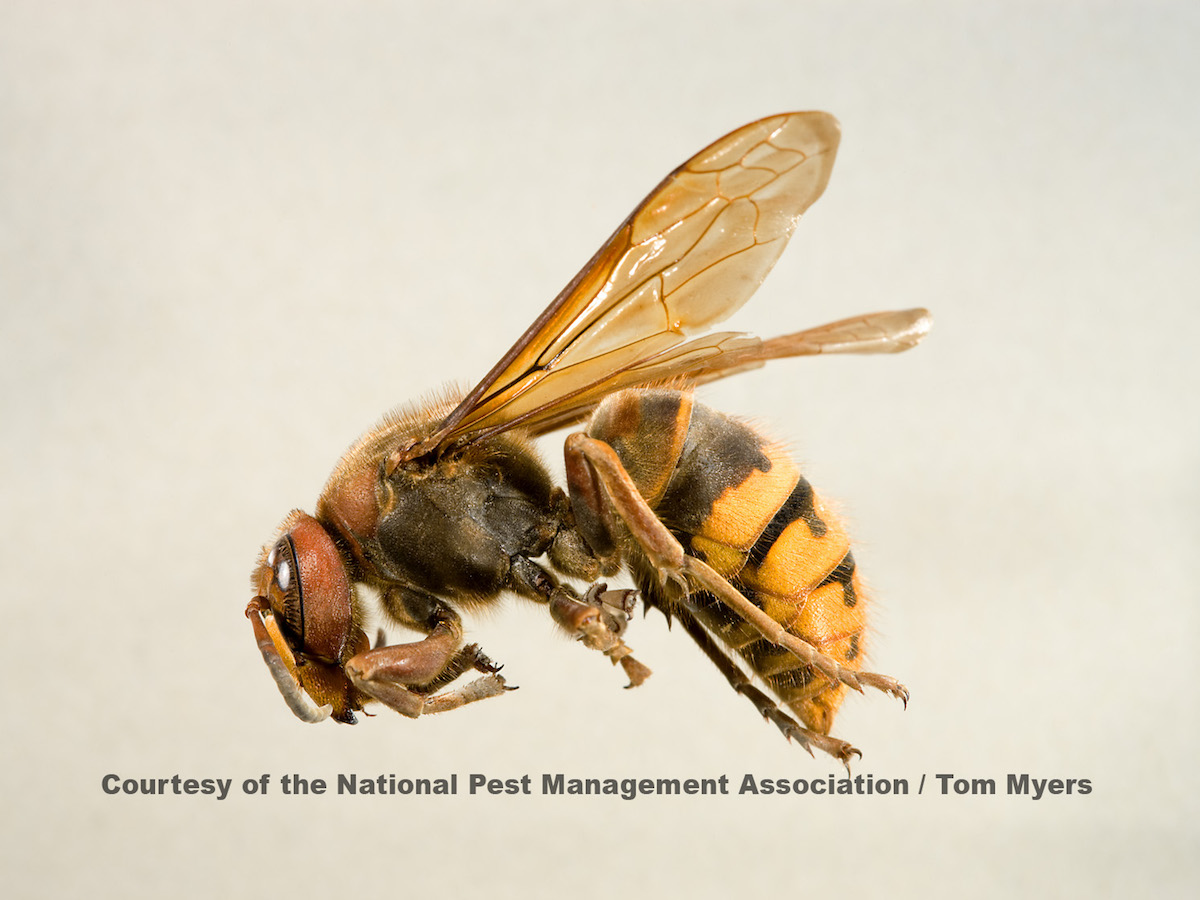European hornets, also known as Vespa crabro, typically travel up to 0.6 miles (1 kilometer) from their nest in search of food and resources. However, in some cases, they may venture further depending on environmental conditions and food availability. This article explores the European hornet foraging range, travel habits, and other critical aspects of their behavior.

Image Source: pestworldcdn-dcf2a8gbggazaghf.z01.azurefd.net
Getting to Know the European Hornet
The European hornet, Vespa crabro, is the largest eusocial wasp native to Europe. Introduced to North America in the mid-19th century, it has since established itself as a significant presence. These hornets are known for their large size, distinctive coloration, and potent sting. It’s vital to distinguish them from other stinging insects to better manage and coexist with them.
What Do European Hornets Look Like?
European hornets are larger than typical wasps and yellowjackets. They have the following characteristics:
- Size: Workers are usually 0.7 to 1.0 inches long, while queens can reach up to 1.4 inches.
- Color: Their bodies feature a mix of brown and yellow markings, with more brown than yellowjackets. The abdomen has distinctive teardrop-shaped markings.
- Wings: They have reddish-orange wings.
- Eyes: Compound eyes are C-shaped.
Where Do European Hornets Live?
European hornets build nests in sheltered locations, often in:
- Hollow trees
- Wall cavities
- Attics
- Barns
They prefer dark, enclosed spaces. The nest is made from chewed wood pulp, which gives it a papery appearance.
European Hornet Travel Habits
To understand how far European hornets travel, it’s essential to look at their foraging behavior and home range. Several factors affect the distance they fly from their nest.
European Hornet Foraging Range
The typical European hornet foraging range is about 0.6 miles (1 kilometer) from the nest. This is the distance they commonly travel to find food, water, and other resources.
Maximum Distance European Hornets Fly
While the average foraging range is 0.6 miles, European hornets can fly further if necessary. The maximum distance European hornets fly can reach up to 1.2 miles (2 kilometers), but this is less common and usually occurs when resources are scarce closer to the nest.
Factors Affecting Hornet Flight Distance
Several factors influence how far European hornets venture from their nests:
- Food Availability: If food is plentiful near the nest, they won’t need to travel far.
- Water Sources: Access to water is crucial, especially in hot weather. Hornets will fly further to find water.
- Nest Size: Larger colonies need more resources, potentially increasing the hornet colony foraging area.
- Environmental Conditions: Weather conditions like wind and temperature can affect flight distance.
- Competition: Competition from other hornet colonies or insects can force them to search further for resources.
What Do European Hornets Eat?
European hornets are predators and scavengers. Their diet includes:
- Insects: They prey on other insects, including bees, flies, and caterpillars.
- Tree sap: They feed on tree sap, which provides them with carbohydrates.
- Fruit: They may also eat ripe or rotting fruit.
- Honeydew: A sweet substance produced by aphids and other insects.
Hornet Home Range Size
The hornet home range size refers to the total area where a hornet colony forages. This area can vary depending on the factors mentioned above. On average, a European hornet territory covers an area within a radius of 0.6 miles (1 kilometer) from the nest, but it can extend further under certain circumstances.
Studying Hornet Movement
Scientists use different methods to study the movement and foraging habits of European hornets. These methods help us learn more about their behavior and ecology.
How Scientists Track Hornets
- Marking and Recapture: This involves capturing hornets, marking them with paint or tags, and releasing them. When the marked hornets are recaptured, researchers can track their movement patterns.
- Radio Tracking: Small radio transmitters are attached to hornets, allowing scientists to track their movements using radio receivers.
- GPS Tracking: Miniature GPS loggers can be attached to hornets to record their precise locations over time.
- Observation: Direct observation of hornet behavior, including foraging and nesting activities.
What Studies Show About Hornet Travel
Studies using these methods have provided valuable insights into hornet travel habits:
- Hornets tend to concentrate their foraging efforts in areas with abundant food resources.
- The distance from nest European hornets venture can vary depending on the time of day and the season.
- Hornets often follow predictable routes when foraging.
- Competition with other insects can influence foraging behavior and distance.
Hornet Nests: Radius and Territory
Understanding the size and structure of hornet nests is essential for managing and controlling them.
Hornet Nest Radius
The radius of a hornet nest refers to the area immediately surrounding the nest. This area is typically defended by the hornets, and they are more likely to sting if they feel threatened. The size of this area can vary, but it usually extends several feet around the nest.
Defending the Nest
European hornets are defensive of their nests and will attack if they perceive a threat. Signs of defensive behavior include:
- Aggressive buzzing
- Flying towards the perceived threat
- Stinging
What To Do if You Find a Nest
If you find a European hornet nest, it’s important to take precautions:
- Stay Away: Keep a safe distance from the nest.
- Don’t Disturb It: Avoid any activities that could disturb the nest.
- Contact a Professional: If the nest is near your home or poses a threat, contact a pest control professional to remove it safely.
Comparing European Hornets to Other Hornets
It’s helpful to compare the travel habits of European hornets to those of other hornet species to get a broader perspective.
Asian Giant Hornet
The Asian giant hornet (Vespa mandarinia), also known as the “murder hornet,” is larger and has a more extensive foraging range than the European hornet. They can travel several miles from their nest in search of food, particularly honeybee colonies.
Bald-Faced Hornet
The bald-faced hornet (Dolichovespula maculata) is another common hornet species in North America. While they are aggressive, their foraging range is generally smaller than that of the European hornet.
Table: Comparison of Hornet Species
| Feature | European Hornet (Vespa crabro) | Asian Giant Hornet (Vespa mandarinia) | Bald-Faced Hornet (Dolichovespula maculata) |
|---|---|---|---|
| Size | Large | Very Large | Medium |
| Foraging Range | Up to 0.6 miles (1 km) | Several miles | Smaller than European Hornet |
| Aggressiveness | Defensive | Very Aggressive | Aggressive |
| Diet | Insects, tree sap, fruit | Honeybees, insects, tree sap | Insects |
Managing European Hornets
Managing European hornets involves taking steps to prevent nest building and safely removing nests when necessary.
Preventing Nest Building
- Seal Entry Points: Seal cracks and openings in walls and foundations to prevent hornets from entering buildings.
- Remove Food Sources: Keep outdoor areas clean and free of food scraps that could attract hornets.
- Maintain Landscaping: Trim trees and shrubs to reduce potential nesting sites.
Safe Nest Removal
- Hire a Professional: The safest way to remove a hornet nest is to hire a pest control professional.
- Protective Gear: If you attempt to remove a nest yourself, wear protective gear, including a bee suit, gloves, and a face shield.
- Timing: Remove the nest at night when the hornets are less active.
- Insecticide: Use an appropriate insecticide to kill the hornets before removing the nest.
Fathoming European Hornet Behavior
Grasping European hornet behavior helps us coexist with these insects and manage them effectively.
Importance of Hornets in the Ecosystem
European hornets play a role in the ecosystem by preying on other insects, including pests. However, they can also be a nuisance and a threat to human safety.
Coexisting with Hornets
- Awareness: Be aware of the presence of hornets in your area.
- Avoidance: Avoid disturbing hornet nests.
- Prevention: Take steps to prevent nest building around your home.
Adapting to Changes
European hornets are adaptable insects that can thrive in a variety of environments. By understanding their behavior and ecology, we can better manage their populations and minimize the risks they pose.
Frequently Asked Questions (FAQ)
What is the average distance European hornets travel from their nest?
The average distance is about 0.6 miles (1 kilometer).
Can I remove a European hornet nest myself?
It is best to hire a professional. If you attempt it yourself, wear protective gear and proceed with caution.
How far do hornets search for food when resources are scarce?
They may travel up to 1.2 miles (2 kilometers) or more.
What attracts European hornets to my yard?
Food sources, water, and potential nesting sites attract them.
What is the best time of year to remove a hornet nest?
Late fall or early winter, when the colony is dying off, is the safest time.
Who is most at risk from European hornet stings?
People allergic to insect stings and those who disturb nests are most at risk.
How far do European hornets fly compared to bees?
Honeybees generally fly further, up to several miles, to collect nectar and pollen. European hornets typically stay within a 0.6-mile radius of their nest unless resources are scarce.
By getting to know European hornets, their travel habits, and how they interact with their environment, we can take steps to safely coexist with them.

Hi, I’m Candace Wafford, a travel and food blogger based in Lexington, Kentucky. As a corporate traveler, I’ve had the chance to explore a lot of places, but now I’m on a mission to travel full-time. My goal? To figure out how to take my cat along for the adventure! Here at destinationdorworth.com, I share my experiences and tips on outdoor activities, travel, and of course, the best food spots I come across. I hope my blog inspires you to explore more and eat well on your journeys!
